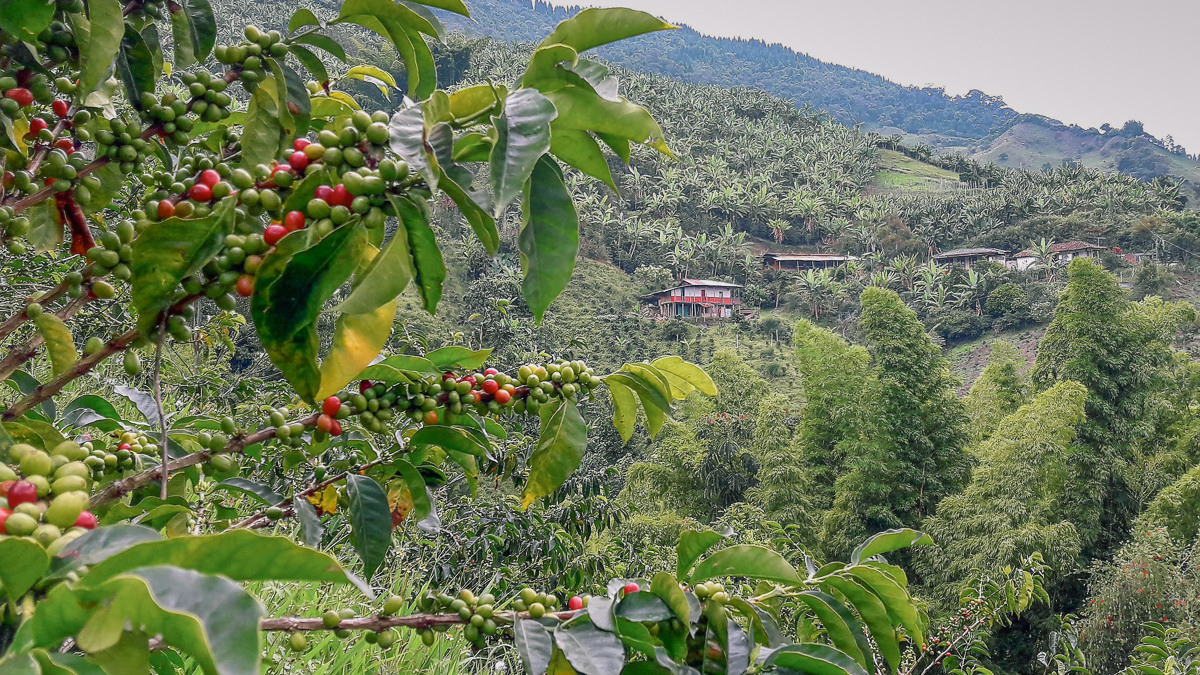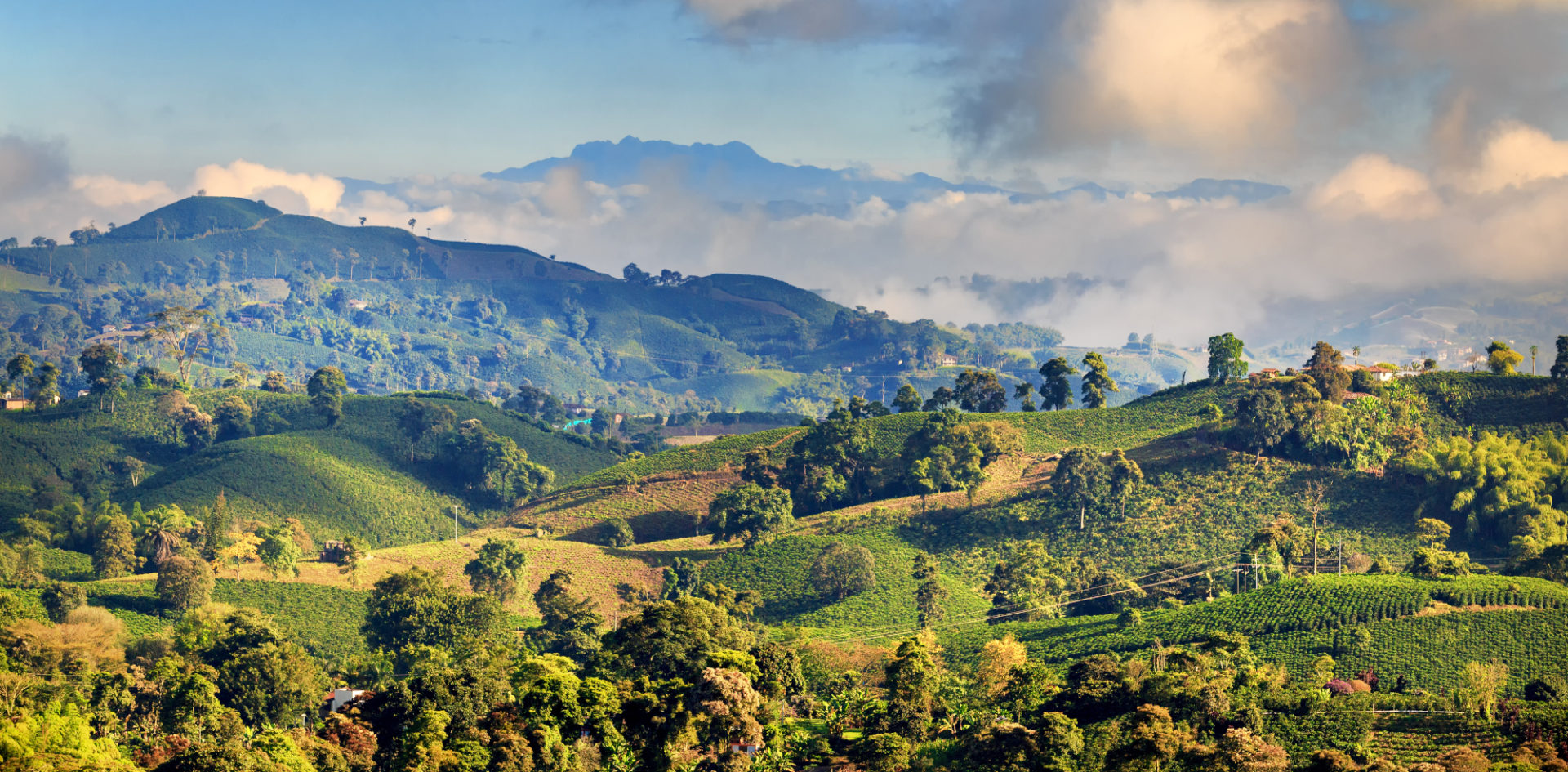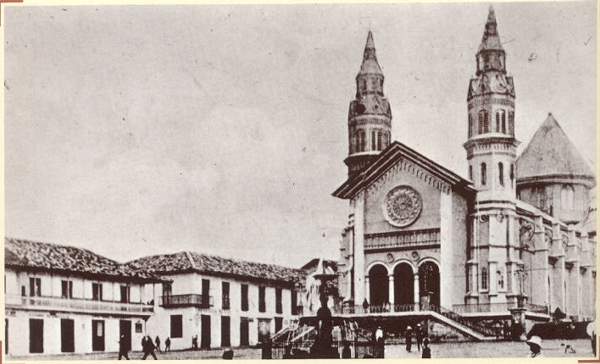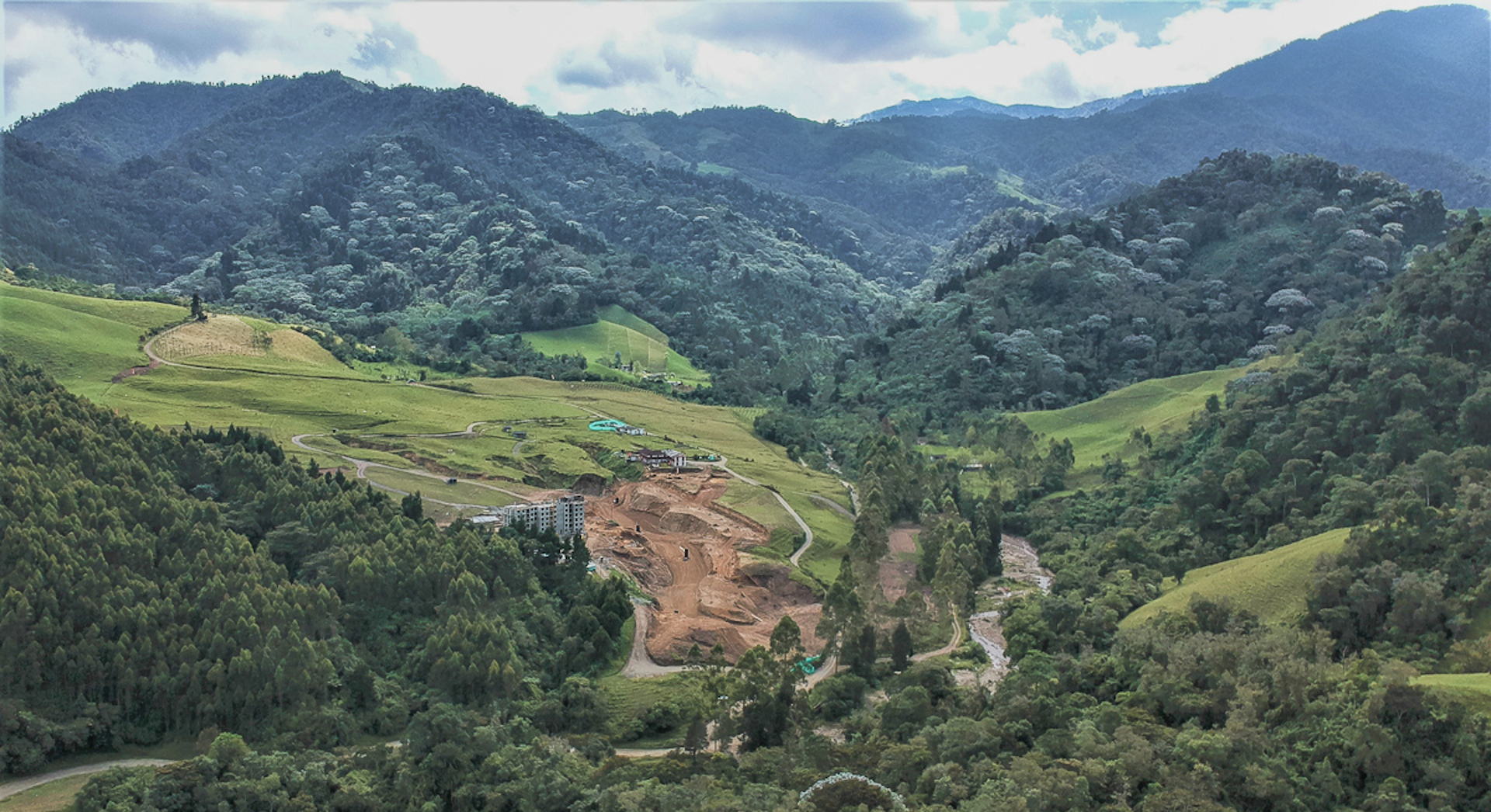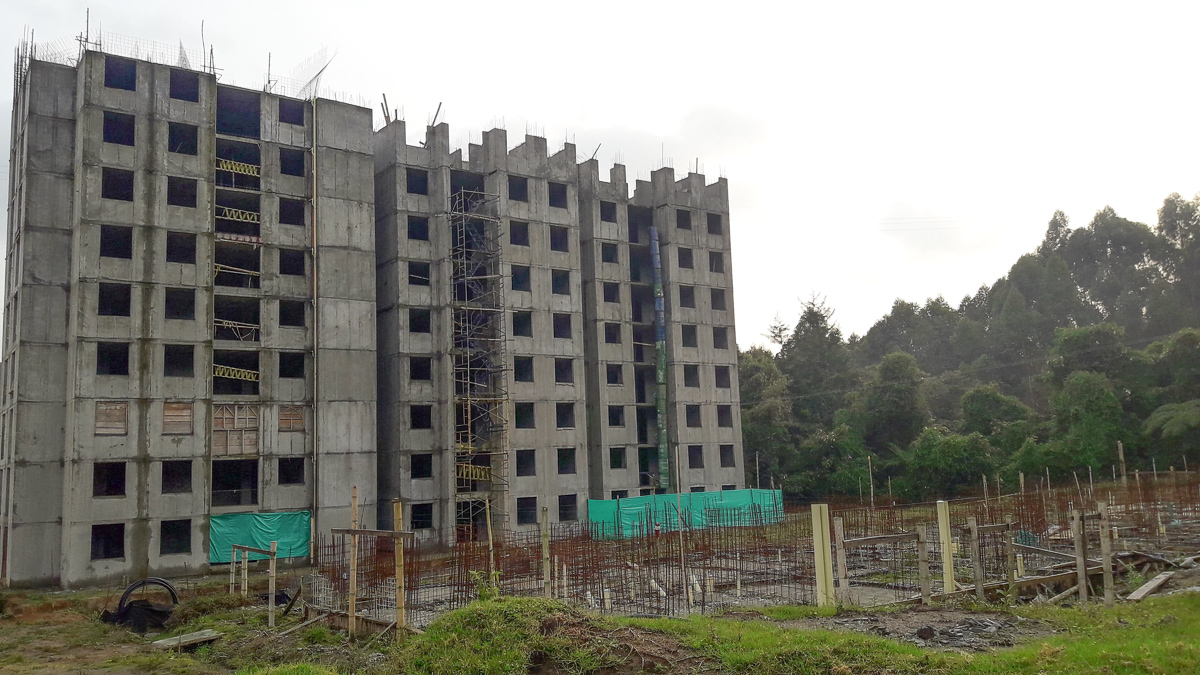View of Manizales Photo: Jess Kraft / Shutterstock.com
The battle for the commons in neoliberal Colombia
- July 23, 2019
Capitalism & Crisis
The local struggle to protect the Rio Blanco ecological reserve epitomizes the resistance against the destructive impact of decades of neoliberal development.
- Author
Arriving in Manizales by air from Bogotá, the airplane glides over a jagged urban topography that juts up and down over ridges and hills. Manizales, capital city of Caldas province in central Colombia, seems disproportionally large, spread thin far beyond the necessity of its half a million inhabitants. Outside the city center, which follows the plaza-centric grid layout derived from the traditional Spanish colonial settlement, the urban fabric cascades into undulating patterns without any apparent logic.
What is puzzling about Manizales is not just this growth beyond demographic need, but even beyond tangible economic foundations. The city’s urban sprawl, however, does respond to a very specific logic: that of neoliberal boosterism. There is little to no profit to be made for developers and financiers in densifying the existing city or in repairing and retooling existing neighborhoods and urban infrastructures to house and provide services to growing populations. Therefore, it is little surprise that, expanding to the tune of financial speculation, Manizales is beginning to encroach upon its own ecological conditions for survival.
The city has now spread to the very outskirts of Rio Blanco, a designated ecological reserve located at the foot of the hills that flank Manizales’s eastern edge. Through fog and rain management, this forested area provides close to a third of all of Manizales’s water. Rio Blanco also forms an important component of the Chinchiná River Basin, a crucial water and soil management life-support ecosystem for the larger region. And yet, despite the importance of this ecological zone to sustaining urban and rural water supplies, the site adjacent to Rio Blanco is currently coveted by developers eager to build on it.
Standing in opposition to this project is Todos Somos Rio Blanco (We are all Rio Blanco). This umbrella organization brings together members from academia, science, law, neighborhood organizations, unions and other elements of civil society in Manizales in their fight against the construction of a residential development next to the Rio Blanco ecological reserve.
Todos Somos Rio Blanco alleges that the construction of the Tierra Viva housing development, advertised as an eco-friendly community for ten thousand people, will cause irreversible damage to the reserve. They emphasize that Rio Blanco is a biodiverse ecosystem home to rare animal and plant species that will disappear if construction of Tierra Viva proceeds. Furthermore, they point out that human intrusion in the protected zone, including the threat of soil degradation, waste pollution and other side-effects of large-scale human habitation, could have devastating consequences for the sustainability of Rio Blanco and of its water-producing capacities.
The battle over Rio Blanco pits civil society against a powerful developer with strong political connections. This struggle, however, also highlights how the logics of neoliberal territorial development have accelerated ecological devastation, urban deterioration, political corruption and violence against social movements in Colombia. It shows, additionally, that the very institutions and planning instruments in place to protect the territorial commons and to align ecological conservation with economic development have been corrupted by this neoliberal logic.
But above all, the battle over Rio Blanco is part of a long and violent history of Colombian primitive accumulation, of the violent destruction and wresting of the territorial commons for the purposes of capital accumulation.
The Topography of Colombian Neoliberalism
Situated on the western slopes of the central of three Andean mountain chains that traverse Colombia, Manizales was once wealthy, one of the three metropolitan regions making up the famed and fertile Coffee Triangle.
This coffee growing zone — a UNESCO designated world heritage region — sits at the foot of the Nevados National Natural Park, nearly 60,000 hectares of protected land containing volcanoes, glaciers and unique water-producing alpine tundra ecosystems known as páramos. The rich soils at the base of the towering volcanoes, spread over eons throughout the surrounding valleys; the abundant water produced by the páramos; the unique fog and rain cycles managed by the delicate balance of glaciers and mountain forests, along with the climactic conditions arising from ideal mountain altitude and tropical latitude, form the basis for growing what is often considered the best mild coffee in the world.
Demand for this coffee was the basis of Colombia’s integration into the global market at the beginning of the 20th century. Coffee powered Colombia’s economic development well into the postwar era. Coffee, its landscapes and its farmers were elevated to iconic status and made emblems of Colombian culture both at home and abroad
Coffee was also at the foundation of Manizales’s prosperity. The city, however, developed a manufacturing and industrial base in the post-World War II period as a result of Colombia’s mild import-substitution industrialization (ISI) policies. The latter diverted rents captured from coffee, petroleum and mining exports into the development of nascent, protected, manufacturing industries.
Then came the 1970s, the breakdown of Bretton Woods, and the neoliberal turn in the United States and Great Britain. Liberalization was ushered along by Colombia’s technocratic elites under the guidance of their IMF and Word Bank counterparts. By the 1990s, as protections for local industry were slashed and barriers to foreign investment and finance removed, economic diversification and local industry were undermined. Deindustrialization ran parallel to a shrinking role of the agricultural sector in GDP as Colombia opened its markets to subsidized crops from the US and Europe. Coffee retained importance as an emblem of Colombian identity, but it now makes up only a tiny percentage of the country’s exports.
By the 1980s and 1990s, Colombia’s development model slowly resituated itself around the capture of rents from extractive industries, principally mining and petroleum. In the agricultural realm, new industrial monocrops such as roses, palm oil and biofuels, as well as illicit coca and poppy refined into cocaine and heroin, respectively, have come to form the bulk of exports.
The extractive development model, the influx of speculative finance and the exorbitant profits to be made in the drug trade drove land accumulation, which fueled existing territorial conflicts. Ranchers, narcos, industrial agrobusinesses, their paramilitary allies and the state, on the one hand, faced off against left-wing guerrillas. The latter, despite tracing their lineage back to dissident peasant communities formed in the 1960s, were now as dependent on illicit drug production and other extractive rents as their rivals.
Subsistence farmers, many belonging to Afro-Colombian and Indigenous communities, as well as union organizers, social movement leaders, journalists and academics, found themselves in the crosshairs of this war over territory. The toll was staggering: the Colombian government estimates that around eight million people were torn from their lands by conflict-related violence since 1985. This phenomenon spread beyond the countryside as the mass-migration of refugees fleeing violence in rural areas filled the ever-expanding rings of misery ubiquitous in Colombian cities.
In much of the Global South, the process of implementing neoliberal policies was dependent on heavy repression and extreme violence. Perhaps most strikingly and famously in Chile, the “free market” laboratory of Milton Friedman and the Chicago Boys, this violence took the form of a US-backed military coup in 1973, followed by economic and social shock-therapy — sudden market liberalization and heavy repression of civil society, including extra-judicial torture, disappearance, and murder.
In Colombia, the process played out in a more diffuse if perhaps bloodier fashion. Gradual liberalization at the national level advanced in tandem with ruthless primitive accumulation of resource-rich lands by ranchers, narcos and the agro-industry, often aided by paramilitary firepower. The brutality perpetrated by guerrilla organizations such as the former Revolutionary Armed Forces of Colombia (FARC) against innocent civilians was substantial, but the body count amassed by the right-wing paramilitaries formed the bulk of the casualties of the Colombian conflict.
It is clear who won this war, as the massive growth of Colombia’s internally displaced population coincided with the accumulation of more and more productive land in fewer and fewer hands, and as forests, wetlands, rivers and other complex ecosystems were opened up to mono-agriculture, mining and other extractive industries.
These wars of primitive accumulation largely affected the low-lying plain regions of the country — areas where cattle ranching and monoagriculture had long dominated — and the resource-rich forested regions along the Pacific coast. Manizales was spared the worst of the violence that tore through the country between the 1980s and 2000s. It could not, however, escape some of the other ravages of neoliberal restructuring: deindustrialization, labor informalization and underemployment.
During a recent visit to the city, a cab driver proudly informed me that in Manizales there are still factories producing shoes, leather goods and refrigerators. This may be the case, but a stroll through the city center reflects what I have seen in other cities in central Colombia: materially decaying if lively commercial districts mostly devoted to selling cheap garments, foreign electronics, and imported home goods, the avenues and plazas full of the underemployed, informally employed, or unemployed.
Outside the old centers, urban development seems to consist almost entirely of speculative, mass-produced residential construction made of the cheapest materials and the glitziest architecture, topped off by enormous malls that cater to the downwardly mobile middle classes and to a tiny elite grown rich via construction speculation, extractive industries and even the provision of social services.
Even if the disastrous consequences of neoliberal policies were at a minimum in Manizales, the violence is nonetheless manifest in the drawn-out decay of the old commercial sectors, in ruinous urbanization and in the everyday penuries suffered by structurally surplus populations, or those whose labor and skills are no longer held in any value by the new neoliberal dogma.
These palpable processes of decay, however, were matched all the while by others occurring beyond the horizons of perception that constitute everyday experience. The unsustainable uses of urban and rural land imposed by capitalist modernization and exacerbated by the neoliberal turn, it turns out, set off ecological disruptions that are only now being clearly seen.
Despite the lag between the onset of processes of ecological devastation and the public’s perception of it, growing consciousness among the citizenry in Manizales about the dire stakes of the current struggle over the uses of land, the conservation of ecosystems, and the access to and use of resources, has given rise to new calls to reinstate citizen control over the territorial commons. These calls are part of a long history of struggles that have led to substantial advances in rights related to territory. But these rights are in tension with the logic of development prevalent in Colombia.
A Clash of Incompatible Tracks
The battle over Rio Blanco brings to a collision what the economist José Antonio Ocampo refers to as the two opposing tracks that have marked Colombian national development since the late 1980s.The first of these dates officially to 1991, the year of the signing of a new national constitution. The origins of this constitution, however, stretch back at least as far as the struggles for the expansion of political representation and land rights fought by peasant and workers’ movements in the 1930s and 40s. Crushed by a unified elite during the 1950s during the period known as La Violencia, a civil conflict that claimed the lives of some 200,000 people, these struggles over land took on new forms in the 1960s and 1970s: the suffocation of land reform in the political sphere led to the formation of peasant squatter movements, peasant defense leagues and guerrilla insurgencies. These elements were brutally repressed by the state and the paramilitary apparatus, but movements for reform found renewed impetus in the student protest movements of the 1980s.
The product of these struggles was a relatively progressive constitution that strengthened the judiciary and granted tangible political, economic, cultural, territorial and social rights. On the territorial and conservation front, the constitution was a substantial advance for the protection of the commons: public institutions were tasked with defending and carefully managing important ecologies and natural resources, and the rights of property were at least formally subordinated to the public interest under the rubric of social and ecological responsibility.
The second track is the economic liberalization implemented in the 1980s. Ocampo’s quantitative macroeconomic analysis confirms that the fruits of neoliberalism were rising labor informality, worsening labor conditions, macroeconomic instability, deindustrialization, the weakening of the agricultural sector, increasing dependence on extractive industries and overall slower growth than the postwar period preceding the neoliberal turn.
The battle over Rio Blanco brings these tracks to an inevitable clash. This clash is shaping the large-scale metabolic relations that link forests, mountains, glaciers, water, rain, flora, fauna, urban spaces, the movement of people and the flows of commodities and finance.
Climate change has made it clear that the fate of the world depends on the balance of these interlocking metabolic cycles and ecological and infrastructural networks, which in Colombia are now crisscrossed by a bitter struggle that has been incorporated into the institutional frameworks for territorial planning since the signing of the new constitution in 1991.
The Contradictions of Capitalist Territorial Planning
In 1573, King Phillip II of Spain promulgated ordinances for the construction of new settlements in Spain’s colonies in the Americas. The new colonial cities were to be set up in a grid with the Plaza Mayor at their center. Here the representative buildings of the church and the monarchy were to be prominently displayed.
The Uruguayan cultural critic Angel Rama argued that the geometrically arranged baroque cities of the Spanish colonies reflected the emergence of a new form of rationality. On the one hand, the very form of the city was supposed to reflect the hierarchical order of the absolutist monarchy. On the other, however, the emphasis on an ideal order conveyed by mathematical symbols and geometry was indicative of the rise of the new abstract rationality of capitalism, a mode of production for which the qualities of unique objects were disregarded so that they could be exchanged as commodities. Despite the continued use of religious iconography to justify Spain’s imperial project, the Spanish colonial cities asserted a wholly instrumental authority on the landscape, motivated not primarily by evangelizing fervor but by the emerging imperatives of capital accumulation and profit.
These baroque cities were primarily spaces for amassing resources extracted from the forced labor of African slaves and subjugated Indigenous communities. For Rama, the colonial cities of Latin America were idealized images of royal authority as well as the first extractive technologies of global capitalism, spaces oscillating between imperial fantasies of order and new institutional frameworks implementing the territorial logic of the market.
Despite the colonial inheritance of extractive urbanism, the postcolonial period in Colombia is characterized by a dearth of ordinances related to urban planning. Perhaps this absence has to do with the relative economic isolation of Colombia from international markets throughout most of the 19th century. Perhaps it has to do with Colombia’s historical position at the periphery of global capitalism. Whatever the case, neither urban nor territorial planning took hold in the geographically fragmented nation, despite many furtive efforts to the contrary, until the period leading up to the signing of the 1991 constitution.
Part of the motivation for developing territorial planning norms in the 1980s was exasperation by politicians and technocrats in the face of runaway informal urban growth: the massive and unofficial counter-land reform being implemented in the countryside via paramilitary violence during this period coincided with the Colombian state’s derogation of its direct involvement in the construction of large-scale public housing in the cities — another casualty of the neoliberal turn. Another motivation was to introduce mechanisms for “rationalizing” territorial planning, code for synchronizing capitalist development with the new rights related to territory, conservation and the social and cultural obligations of property mandated by the 1991 constitution.
The 1991 constitution tasked municipalities and national level institutions with new responsibilities, from managing the provision of public services to developing and overseeing territorial conservation. The laws of territorial planning developed in the 1990s, however, envisioned territory as a matter of interlocking scales that connected cities to their agricultural hinterlands and the latter to regional, national and international economic assemblages.
The Spanish colonial cities in the Americas could be interpreted, following Rama, as harboring an inner tension, between representing the utopia of a static monarchical hierarchy on the one hand, and facilitating the fluid logic of capitalist markets on the other. A similar tension is at work in the slippages of the concept of territory as developed in Colombia, a tension that reflects the lack of fit between the notion of the territorial commons and logics of neoliberal resource extractivism.
This irresolvable contradiction appears clearly in the case of Rio Blanco, where the instruments of planning have become a battle ground between the forces mobilized in defense of the commons and those seeking to extract profit from them.
The Case Against Tierra Viva
The current fight over Rio Blanco dates to December 2003. In an extraordinary session, the Municipal Council of Manizales convened to change the city’s 2001 Plan for Territorial Ordering (POT). The POT is a territorial planning instrument that is supposed to coordinate the use of land by public and private actors over a period of three municipal administrative terms. The 1997 law that instituted the POT mandates every city over 100,000 inhabitants to develop its own plan. Manizales created its first POT in 2001. The first general revision of the city’s POT was carried out 2017.
Just a month prior to the fateful meeting of the municipal council, Felipe Calderón, the director of the firm behind Tierra Viva, appeared before the city’s Municipal Council representing the Colombian Chamber of Constructors (CAMACOL). Calderón stated his approval for the new criteria developed by the council for defining urban expansion as determined by population growth. He seemed to imply, additionally, that in the future it would be important to expand construction into sloped areas adjacent to the city in order to “stabilize” them — presumably to control for landslides, though the minutes from this meeting are not explicit on this account.
These are just some of the irregularities that activists mobilizing against the construction of Tierra Viva point to in their efforts to derail the project. They also allege conflicts of interest that suggest a conspiracy to use the POT for speculative purposes. These include the close links between the owner of the property where Tierra Viva is to be built, the administrative bodies responsible for overseeing the approval of city development projects and for managing the Rio Blanco reserve, and the developer.
Jorge Alberto Vélez Jaramillo is not only the owner of the property adjacent to the forest reserve, he is also a member of the board of directors of the firm behind Tierra Viva and he served in a management role in Aguas de Manizales at the time the disputed changes to the POT were made in 2003. Aguas de Manizales, the private firm that manages the city’s water services, would have had to approve the change in designation of the land adjacent to Rio Blanco. Velez Jaramillo is no stranger to corruption: in 2012, he was found guilty of embezzling public funds when he was administrator at Aguas de Manizales in 2002 and 2003, a conviction ratified by higher courts in 2017.
Additionally, documents filed in a regional court and with the Inspector General claim that the approval of construction adjacent to Rio Blanco violated national norms that specify the buffering role of zones adjacent to protected land. It is alleged that redactions were made retroactively to public documents produced by administrative bodies in Manizales eliminating references to this buffering role. This is just one of the many instances that suggests that approvals to construction plans and permits took place despite knowledge by the relevant decision-making bodies on the environmental impact of development next to Rio Blanco.
The original suit against Tierra Viva took the form of an accion popular (popular act) filed in district court in 2012 by three citizens, two of whom were later apparently convinced to dissociate themselves from the suit. It was around this time that the drafting of the Partial Plan of the project and the application for construction licenses took place.
Todos Somos Rio Blanco, which formed in 2017, would eventually step in to support the suit. The organization’s support has been crucial. Not only has it mustered technical, legal and academic knowledge, but just as importantly, it has raised public awareness of what is at stake in the battle over Rio Blanco. It has held protests in the city and in front of Manizales’s Palace of Justice and organized community discussions and academic forums. The group even managed to gather 12,000 signatures against the Tierra Viva project.
After years of inaction from regional judicial courts on various suits brought against the Tierra Viva project, and due to the lack of support from any local or regional public entities, members of Todos Somos Rio Blanco approached Colombia’s Inspector General in February of 2018 during an assembly in the nearby city of Armenia, asking him for a short audience.
The Inspector General of the Republic is a judicial control institution independent from the other branches of the state, and the Inspector General is voted in by the senate. The serving Inspector General, Fernando Carrillo Flórez, was a leader in the student movements that paved the way for the National Constituent Assembly of 1991.
Carrillo Florez took interest in the Rio Blanco case, delegating three sub-inspectors to work with the activists to gather evidence and information for a prospective investigation by the Inspector General’s office.
The complaint filed with the Inspector General makes note of the fact that the Territorial Planning Council, an institution designed to involve the public in the development of the POTs, is headed by a member of CAMACOL, the Chamber of Constructors. This has led to more clashes of interest, evident in the exact coincidence between the council’s proposals for the 2017 adjustments to the POT and those proposed by CAMACOL. These proposals sought to remove mechanisms for distributing surpluses from new development arising from changes to the POT among affected actors. In other words, the constructors were suggesting that developers reap the entirety of economic benefits arising from territorial changes made in the POT.
The developer’s response to the claims made by Todos Somos Rio Blanco have been cavalier. According to the builder, what is at stake here is a matter of investor confidence, the defense of property rights and the state’s respect for rights conferred in the form of construction permits. Thus far, the relevant administrative oversight institutions at the city and regional level have backed up the interests of the builder.
A Preliminary Victory
Colombia’s neoliberal economic framework has liberated powerful speculative forces. In a country that does not manufacture much of anything anymore and that relies on extractive industries and speculative construction for economic growth and urban development, the motivations to infiltrate the process of territorial planning for primitive accumulation of lands and ultimately for financial gain are powerful.
Nonetheless, the constitutional framework of 1991, which conferred positive rights relating to social services, territory, and conservation, has created a formal buffer that in a sense has the capacity to slow down these speculative forces. However, the institutional and normative frameworks for regional planning are crisscrossed by contradictory trends: the expansion of rights relating to territory, on the one hand, and the imperative to synchronize these with neoliberal development, on the other. The very institutions designed to conserve and defend the commons are open to instrumentalization for speculative ends, ends powered by the logics of neoliberal globalization.
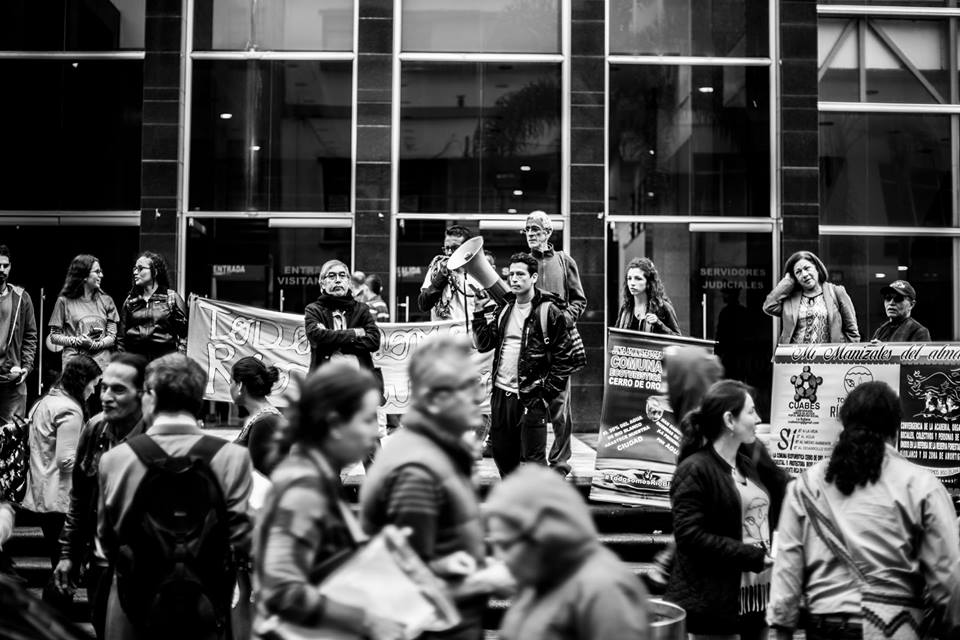
Protest led by Todos Somos Rio Blanco against the Tierra Viva project in Manizales. Photo by Juan Gabriel Arango
In Manizales, a mobilized citizenry has been able to harness scientific studies, expertise in the law, social media strategists, and the expertise of biologists such as Juan Gabriel Arango, a social movement leader and head of a local NGO, Natural Seeds Alliance, who has been active in coordinating protests and suits against Tierra Viva. The strength of groups such as Todos Somos Rio Blanco stems from the capacity of people like Juan Gabriel to make the connection between the complex operations of glaciers and soils, the extractive logics of neoliberalism, speculative activity, administrative corruption and the devastation of the territorial commons.
Through these battles, people are beginning to see the commons as extending to soil, water, forests, housing, work and the very complex set of metabolic cycles and relations through which these are connected. These are complex forms of relationality that neoliberalism reduces to its one-dimensional logic: the self-realization of capital, which is the maximization of profit.
The power of the citizenry was evident in open meetings held by the municipal council in 2017 as part of the process of amending the POT. Two hundred citizens showed up to participate in the two-day open forum. In over 60 presentations, environmentalists, trade unionists, professors, students and other members of civil society, argued against the designation of the region adjacent to Rio Blanco as an urban expansion zone.
Juan Gabriel was among those speaking at the forum. He spoke about the rare bird and animal species that would leave the Rio Blanco should construction of Tierra Viva proceed. He finished his intervention by quoting Bertolt Brecht: “Who does not know the truth is a fool; who knows the truth and calls it a lie is a criminal.”
This citizen mobilization was rewarded by the current council with the re-designation of the zone adjacent to Rio Blanco as rural area.
Ever since the first suit filed against the project in 2012, the construction company has continued operations as permits allowed, presumably in order to create more judicial grounds for defense of its acquired property and construction rights. In fact, they appear to have torn down existing forest to make way for at least one tower.
The mobilized citizenry kept a close eye on the developer’s actions, videotaping and photographing changes made to the area adjacent to Rio Blanco, and carrying out scientific studies of land stability, soil integrity, water quality and existing fauna and flora.
Finally, in 2019, Juan Gabriel and a group of lawyers in Bogotá brought a suit against the project. It resulted in an injunction against further construction activities on the site until all the suits brought against the project are decided.
Early this year, in response to the complaint filed with his office, Inspector General Florez opened investigations against various bureaucrats in Manizales, citing irregularities in changes made to the POT and in the approval of permits and plans linked to the Tierra Viva project. Additionally, Florez called on the local courts handling the suits against the project to accelerate proceedings.
The War Over the Commons
For the moment, the mobilized citizenry in Manizales seems to have won the battle of Rio Blanco. The speculative drives powered by the financialized logics of neoliberalism, however, continue accelerating and expanding their reach all over Colombia, Latin America and beyond, looking to accumulate lands that could yield lucrative returns in investment, either through speculative urban development, through mining, or through industrial export agriculture.
As the case of Rio Blanco shows, the long battles against the capitalist accumulation of land that resulted in the granting of substantive rights related to territory in 1991, have been partially displaced. These battles are now fought on several terrains, including institutions of governance and of urban and regional planning tasked with squaring two antagonistic interests: neoliberal development and the conservation of the territorial commons. This displacement of the conflict over territory to the administrative and planning realm hasn’t made capitalist primitive accumulation any less deadly. The battles over territory have instead taken on new forms. The mobilized citizenry is beginning to make use of the new planning and justice institutions to claim their territorial rights. However, the speculative logics of neoliberal development have made these same institutions instruments through which to accumulate urban and rural territory for resource extraction or speculation.
With the election of President Iván Duque in 2018 and the return of the hardline right-wing to power, the tempos of violent primitive accumulation are once again ratcheting up. The demobilization of the FARC and the move towards peace between this guerrilla organization and the Colombia government in a sense has only intensified this type of violence: the land restitution initiatives included in thepeace plan seem to have set off a scramble by the forces of extractivism and primitive accumulation to secure as much land as possible. According to the Institute of Studies for Development and Peace (Indepaz), 566 social movement and human rights leaders were assassinated between January 2016 and January 2019, with 252 of these murders taking place in 2018. Among the most affected by this violence are Indigenous and Afro-Colombian communities on the frontlines of the battles against mining and ecological devastation.
So far, 2019 is turning out to be another bloody year for the front-line defenders of Colombia’s ecological commons, with Indepaz tracking a total of 80 murders of social movement leaders through the middle of June. Many of the affected communities inhabit rural zones far from major urban areas. They rely on far fewer allies and can draw on far fewer resources than the mobilized citizens of a formerly industrialized, coffee growing, university town like Manizales. Many of these community leaders are protecting ecologies just as vital as Rio Blanco or the Nevados — whose glaciers, crucial for climate and rain regulation in the Coffee Triangle region and beyond, are on the verge of disappearing as a result of climate change.
The structural marginality of these social movement leaders makes them easy pickings for shadowy speculative interests, whether they be unscrupulous regional political, commercial, and landowning elites willing to team up with criminal armed networks to eliminate obstacles to speculative profiteering in the form of local environmental or labor activists, or multinationals that can easily delegate such activities to local actors without leaving much of a paper trail.
These endangered community leaders can only partially rely on the normative framework set in place by the 1991 constitution to battle the forces of primitive accumulation driven by neoliberal financialization and extractivism. The very tools of territorial planning and oversight that exist in Colombia, after all, are crisscrossed by the contradictions that arise in the attempt to synchronize citizen control over the territorial commons with the imperatives of the neoliberal form of capitalist accumulation.
Source URL — https://roarmag.org/essays/the-battle-for-the-commons-in-neoliberal-colombia/


